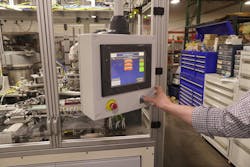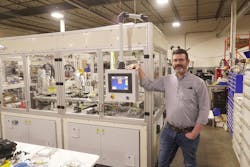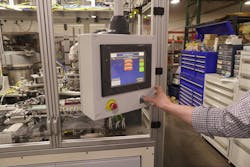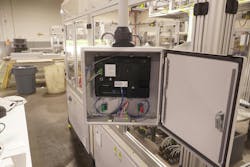Standardized HMIs Streamline Custom Automation Equipment
Industrial automation is applied to visualize and control a wide range of applications, ranging from massive stamping presses to small machines. While such equipment ideally runs itself, human interaction is still essential for setup, monitoring, troubleshooting and to simply start the machine.
Physical buttons, electromechanical dials and other physical devices once filled this critical interface role, but today the versatile input/output capabilities of touchscreens as human-machine interfaces (HMIs) present massive advantages for production facilities, original equipment manufacturers (OEMs) and systems integrators (SIs) alike.
I have worked in the field of industrial automation for more than 30 years, first as an employee of a large automotive supplier, and currently as owner of PMi2 in Seneca, S.C. (Fig. 1). PMi2 is unique in that about half of its business consists of production machining services, with the other half centered around producing automated equipment and integrating turnkey automation for industrial customers—both locally and worldwide. Each side of the business complements the other, increasing opportunities to obtain new clients and take on new types of projects.
Automated equipment takes on many forms at PMi2, and the company follows an ISO 9000-registered process for design and manufacturing. Examples include individual production machines, discrete parts assembly, testing/inspection gear, robotics and machine feeding and tending hardware. They serve diverse industry sectors including automotive, energy, electronics/batteries and pharmaceutical/medical. As a systems integrator (SI) tasked with addressing so much variety, PMi2 is always looking for ways to streamline workflows and optimize projects.
Standardization in a Non-Standardized World
Factory automation of machinery is, by its very nature, customized to meet numerous requirements. Making millions of widget X requires a vastly different machine—or, most likely, machines—than widget Y. Even a relatively typical type of machine will be subject to very specific requirements for each end-user.
READ MORE: A Race to the Micro Pushes the Device Assembly Envelope
At the same time, PMi2 and other SIs resist reinventing things over and over. Using standardized components when possible—especially when dealing with programmable components like HMIs and programmable logic controllers (PLCs)—saves meaningful amounts of labor and expenses and results in a better product.
To this end, PMi2 has developed a typical template on which their machines are built, for both hardware and software. This allows them to skip, or at least shortcut, some early design decisions. PMi2 has found that most of their client base will strictly require the use of a specific PLC brand, so this is always a design constraint. Clients may also establish requirements for commodity components such as relays and circuit breakers. However, almost every client will accept PMi2’s choice of HMI. Based on this knowledge, and many years of hands-on experience, PMi2 has standardized on AutomationDirect C-more series HMIs (Fig. 2).
These HMIs are an easy choice when specifying hardware. Their form factors are compatible with a range of PLC brands (Fig. 3), which simplifies bill of materials (BOM) development. In addition, the HMI configuration software is available for free, which circumvents expensive upfront and ongoing licensing arrangements.
HMI standardization presents other benefits from an integrator’s perspective, most notably in the form of time savings realized via setup familiarity with a specific device and development of semi-standardized interface layouts and curated object templates. For these reasons, PMi2 estimates their team saves 40 to 50 hours of labor per machine by sticking with the one HMI family, because they avoid starting from scratch.
Although they rarely need support because the HMI hardware and software is intuitive, they appreciate the online manuals, help resources and technical videos. In addition, if there is ever a critical issue, support is just a phone call away.
From an end-user perspective, HMI standardization means that fewer spares need to be kept on hand. Engineers, maintenance personnel and operators quickly get up-to-speed on new equipment due to their familiarity with a typical interface. For end users able to support their own equipment, freely downloadable software tools avoid the dreaded situation where a machine is down and technicians must struggle to find or obtain a license under pressure and often outside of regular business hours.
Versatile New Features, Reliable Old-school Methodologies
Alongside standard on-machine HMIs, PMi2 often integrates remote machine control via the free C-more Remote HMI app, which can be installed on Android and iOS devices. With this app, users located anywhere in the world with internet access to the locally installed HMI can view a near-identical interface experience, so they can monitor and control operation if they have the proper credentials.
At many sites, end-users like to implement Remote HMI on inexpensive in-plant tablets with a ruggedized case, providing workers with a flexible and mobile machine interface. This enables technicians to operate a machine from any safe position while examining the physical results in real-time. Engineers no longer must stretch from one position to another, yell commands to another operator or run between locations. Immediate information is available wherever it is convenient.
Of course, even in today’s touchscreen and remote interface world there remains a place for real, physical buttons. Repeatedly performed actions—such as start, stop, reset—and certainly emergency stops are best served by an actual button, even if there is a redundant virtual equivalent on the HMI.
Standardization Supports Business Growth and Long-Term Relationships
With dual roles of machine shop and systems integrator, PMi2 helps a large clientele needing one or both services and has developed long-term relationships and steady growth via word-of-mouth. Even though the applications may vary widely, both PMi2 and their clients benefit from a single, standardized HMI platform that needs minimal learning curves and simplifying BOMs and spares requirements.
The labor and materials savings are notable for single machines. But because some machine production runs number over 10 units—occasionally up to 100 units over time—any savings can multiply significantly. PMi2 also relies on a wide range of other products such as circuit breakers, relays, buttons and more, all easily searchable and readily available via the AutomationDirect website.
Standardized HMI solutions have enabled PMi2 to meet user requirements in a timely and cost-effective manner while delivering high-quality, reliable machinery, and the company looks forward to increased growth and success in the future. Every OEM, SI and end-user in the manufacturing space should always be on the lookout for new devices that will improve factory performance. Having a go-to HMI standard can save time, effort and end-user frustration.
About the Author

Eric Cline
Owner, PMi2
Eric Cline, PE, is a mechanical engineer with more than 30 years of factory automation experience. He has owned PMi2 for the past 20 years. Eric lives with his family in Clemson, SC, where he can see the Blue Ridge Mountains and hear the Tigers play on Saturdays in the fall.



